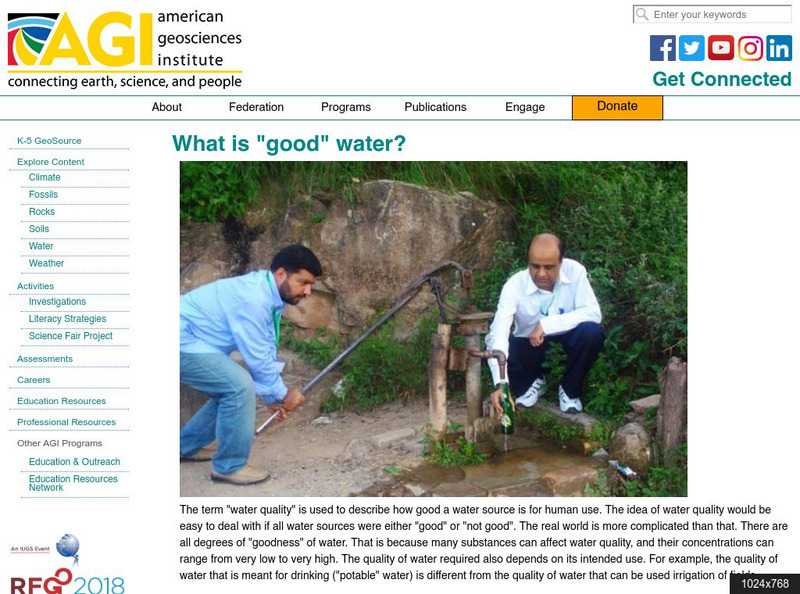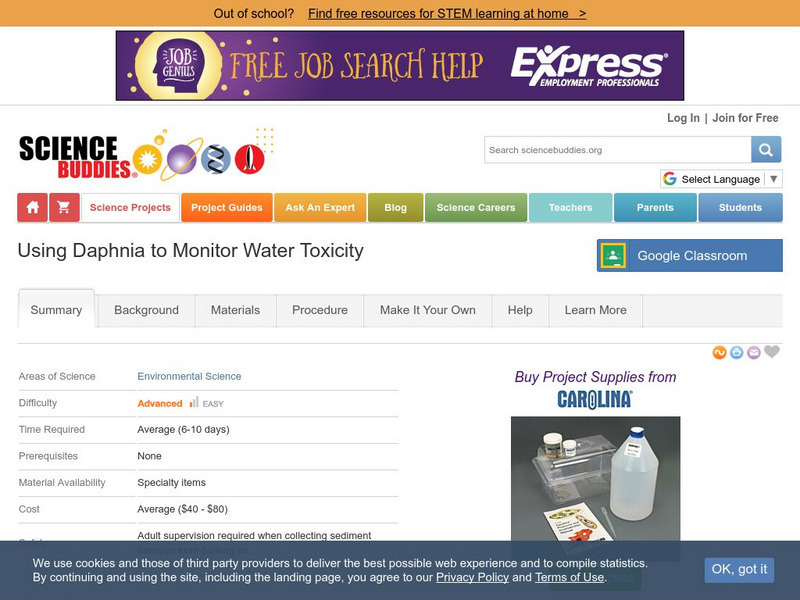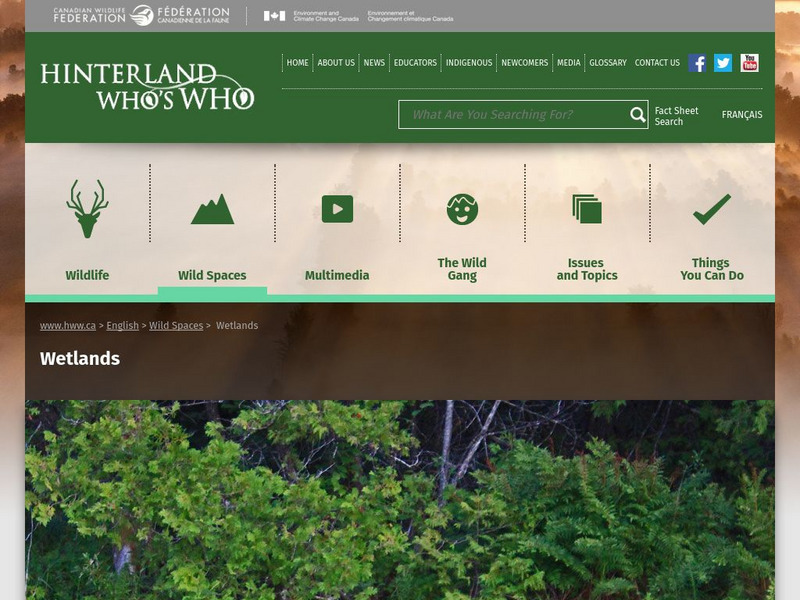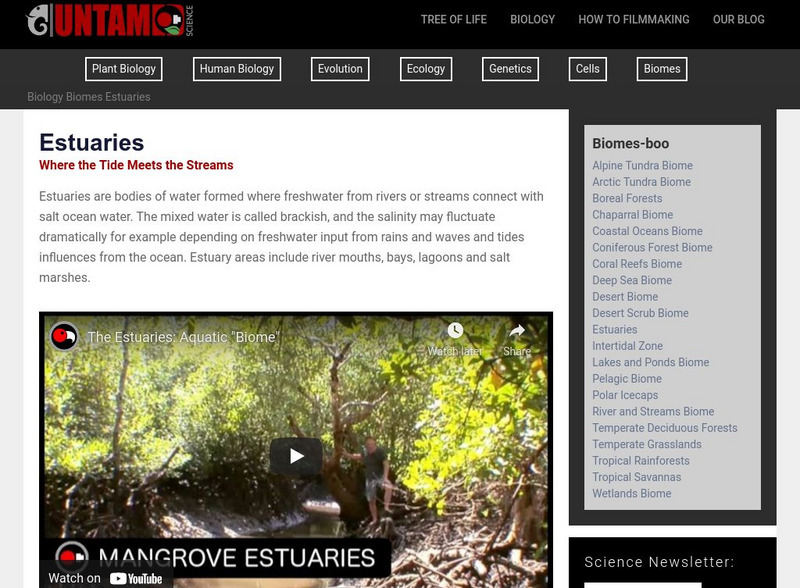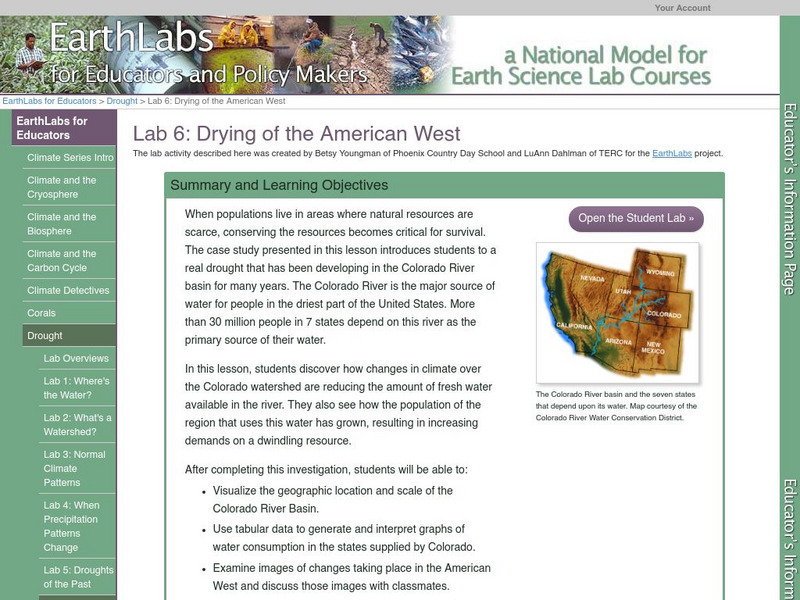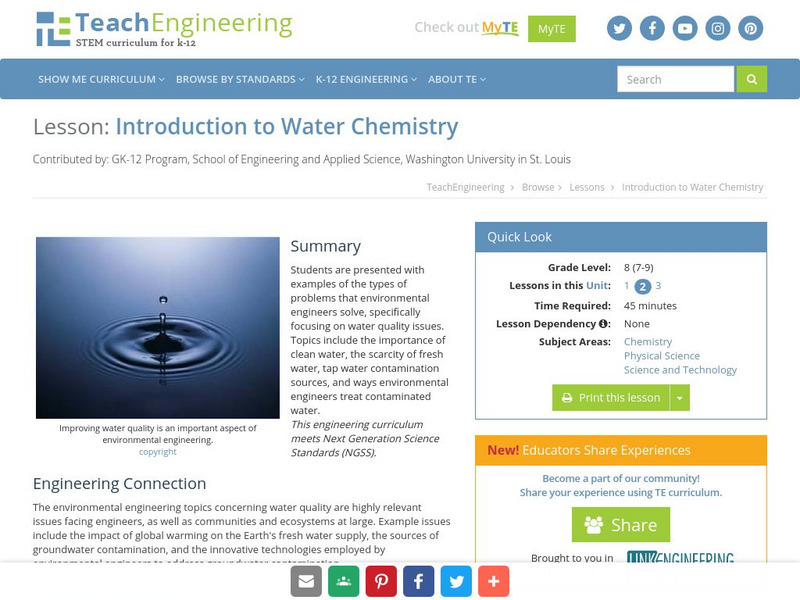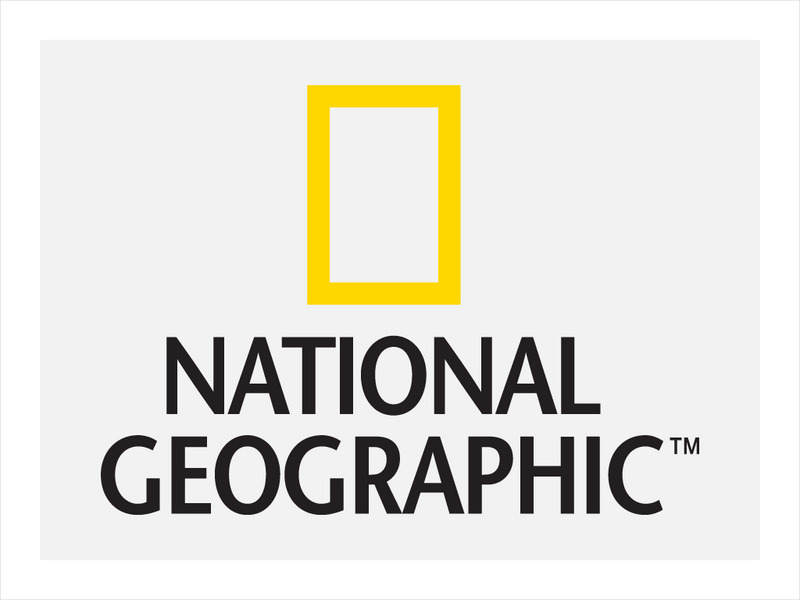Hi, what do you want to do?
American Geosciences Institute
American Geosciences Institute: What Is Good Water?
Learn about the term water quality, and how it is used to describe water sources for human use.
American Chemical Society
Inquiry in Action: Changing the Density of a Liquid: Adding Salt
In this activity, students will see that a carrot slice sinks in fresh water and floats in saltwater. Considering the placement of the carrot slice in water and salt water, students will infer that the density of salt water must be...
Idaho State University
Idaho State University: Water Pollution
Explore water pollution in surface water and groundwater and investigate the treatments for both. Also, check out what happens when salt water infiltrates the fresh water sources.
PBS
Pbs Learning Media: Scent of an Alewife
This video segment from NOVA: "Sea Behind the Dunes" tracks the return of spawning alewife fish from the open ocean back to the freshwater streams and ponds where they were born. [3:34]
Science Buddies
Science Buddies: Solar Powered Water Desalination
Here is a cool project about making fresh water from salt water using solar power, also known as water desalination. The apparatus is made from readily available materials, and the power source is free. As an inventive thinker, you will...
Science Buddies
Science Buddies: Using Daphnia to Monitor Water Toxicity
In a bioassay, a living organism serves as a detector for toxins-the same way canaries were used in coal mines to detect invisible toxic gases. In this project, water fleas (Daphnia magna), a freshwater crustacean, are used in a bioassay...
Science Buddies
Science Buddies: Caffeine and Heart Rate: A Pharmacological Study Using Daphnia
In this project, water fleas (Daphnia magna), a semi-transparent freshwater crustacean, are used to study the effects of caffeine on heart rate. You do not have to learn how to take a crustacean's pulse though, because you can actually...
Canadian Wildlife Federation
Hinterland Who's Who: Wetlands
Learn about Canada?s wetlands, what they are and where they are located. Wetlands are divided into two classes: freshwater and saltwater. They are further separated into four main types: ponds, marshes, swamps, and peatbogs. Discover the...
Canadian Wildlife Federation
Hinterland Who's Who: Estuaries
Learn about estuaries, where the fresh water rivers meet the salt water of the oceans. The unique features of estuaries are explained, followed by a look into estuarine food webs. Next find out about the different plants and animals that...
Climate Literacy
Clean: Effects of Increased Co2 in the Air on Seawater and Distilled Water
Students perform an experiment comparing the impacts of CO2 on salt water and on fresh water. In a short demonstration, students examine how distilled water and seawater are affected differently by increasing carbon dioxide in the air.
Other
Project Wet: Discover Water
Interactive opportunities which emphasize the impact water has on our lives. Explore watersheds, ocean water, fresh water sources, and ways to use water responsibly by engaging in activities, coloring pages, and short quizzes.
Other
Florida's Springs: Protecting Nature's Gems
Explore Florida's springs, some of the world's largest freshwater springs. Here is a well-done site that includes information about threats to these unique springs, natural and cultural history, Florida wildlife, underwater cave systems,...
Other
Water Resources Programme: Chemistry of Carbonic Acid in Water [Pdf]
A detailed look at carbon isotopic composition isotope and carbonic acid in water. Sections include: "Carbonic Acid Equilibria," "Carbonic Acid Concentrations," and "Closed System, Mixing of Freshwater and Seawater."
Other
Alberta Riparian Habitat Management Society: What Is Riparian?
Learn what riparian areas are, why they are important for the health of standing and moving fresh water, how to assess their health, and how to take care of them.
Untamed Science
Untamed Science: Biology: World Biomes: Estuaries Biome
Make learning about Earth's biomes fun and easy with video clips, photographs, and diagrams. Learn about estuaries, the water environments formed where freshwater from rivers or streams mix salt ocean water. [6:38]
Science Education Resource Center at Carleton College
Serc: Lab 2: Anatomy of Coral
A lab experiment in a series of experiments that investigates coral. In this activity, students will use a microscope to examine the feeding behavior of a hydra, a fresh-water relative of coral. They will also observe the characteristic...
Science Education Resource Center at Carleton College
Serc: Lab 6: Drying of the American West
A lab experiment in a series of experiments that explores droughts. This experiment is presented as a case study for the drought conditions in the Colorado River. With this case study, students study the decrease of fresh water...
TeachEngineering
Teach Engineering: Introduction to Water Chemistry
Young scholars are presented with examples of the types of problems that environmental engineers solve, specifically focusing on water quality issues. Topics include the importance of clean water, the scarcity of fresh water, tap water...
National Geographic
National Geographic: Blog: Tiny Critter Has Seven Sexes
Meet the freshwater Tetrahymena, a single-celled creature that has seven possible sexes. This article presents information from recent research that helps explain how the creature reproduces and how its sex is determined.
PBS
Pbs Learning Media: North American Rivers and Their Widths
Rivers are essential to any society. They provide fresh water, recreation, and transportation. Students will analyze the distribution and relationship among North American rivers using this map from NASA. Background information and...
NOAA
Noaa: Estuaries 101 Curriculum: Salinity and Tides in York River
In this learning activity, students explore tides and salinity from tidal freshwater to high salinity conditions along the York River estuary. They learn how salinity changes with an incoming and outgoing tide, observing the dynamics of...
National Geographic
National Geographic: Education
Excellent, comprehensive site from National Geographic that provides lesson plans, activities, maps, and National Geography Standards. Teachers can find lesson plans based on grade and standard. Covers current issues, for example, global...
NOAA
Noaa: Estuaries 101 Curriculum: Nutrients in an Estuary
An overload of nutrients, called eutrophication (Greek for "good-nutrition"), can be harmful to estuaries. This phenomenon is also referred to as "over-enrichment," or "nutrient pollution". Students will investigate the range of...
Environmental Education for Kids
Eek!: Discover the Great Lakes
The Great Lakes include, Superior, Michigan, Huron, Erie and Ontario. These lakes form the largest fresh water system on earth and they are North America's greatest natural resource. Learn about the different lakes, how they formed,...
Other popular searches
- Freshwater Fish
- Freshwater Ecosystems
- Fresh Water Pollution
- Freshwater Organisms
- Fresh Water Salt Water
- Freshwater and Saltwater
- Fresh Water Sources
- Fresh Water Ecosystems
- Freshwater Wetlands
- Fresh Water Biomes
- Boiling Point Fresh Water
- Freshwater Habitats





